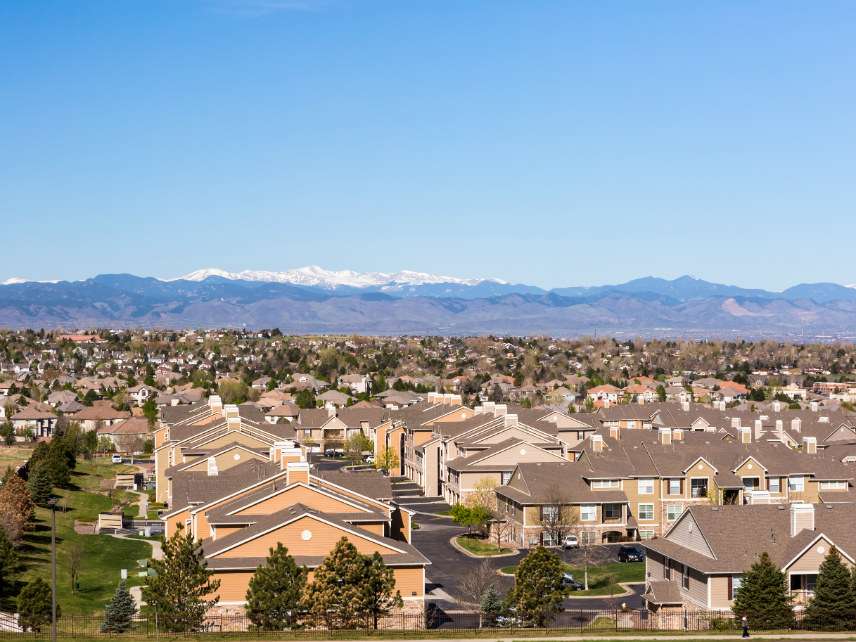Zoning Makes the Green New Deal Impossible
A bad idea is made worse by its inability to grapple with local land use restrictions.

Rep. Alexandria Ocasio-Cortez's (D–N.Y.) Green New Deal is as ambitious a policy proposal as they come, demanding a complete conversion to net-zero carbon emissions within a decade. One means of achieving that goal is the rebuilding or replacement of every single building in the country.
Through a 10-year national mobilization, Ocasio-Cortez's plan calls for "upgrading all existing buildings in the United States and building new buildings to achieve maximum energy efficiency, water efficiency, safety, affordability, comfort, and durability, including through electrification."
A FAQ released alongside the Green New Deal (which has since been deleted from the Congresswoman's website) included as one of its 14 "infrastructure and industrial projects" a promise to "upgrade or replace every building in US for state-of-the-art energy efficiency."
This, combined with a conversion to 100 percent renewable power, and massive investments in transit, is the Green New Deal's strategy for getting us to zero net-emissions in ten years.
Replacing all the buildings in the country over 10 years is a tall order, to say the least.
The U.S. Census Bureau pins the number of housing units at 137,407,308 as of 2017. That count overstates how many residential buildings there are in the U.S. given that roughly 30 percent of these units are contained in larger apartment buildings.
Nevertheless, the Green New Deal would likely require the renovation or replacement of close to 100 million residential structures. Add to that the roughly 6 million commercial buildings in the U.S., plus all the public schools, government offices, and industrial buildings in the country, and we're talking about a lot of retrofitting.
The price tag for all this would be astronomical. It's also somewhat beside the point. Even if the money were available (I suppose we could always print it), local and state land use policies would stop any such green development bonanza in its tracks.
"Current zoning absolutely stands in the way of allowing more people to live in high cost areas that are already close to transit," says Emily Hamilton, a scholar at George Mason University's Mercatus Center.
Most major American cities have imposed single-family zoning—which allows for a single dwelling per property to be built—on a majority of urban residential land, says Hamilton. This puts an artificial cap on the number of new homes that can be built.
It forces people to live farther away from each other than they might otherwise want to, making it harder to service all of them effectively by transit. That presents a problem when one's vision is so dependent on people giving up their carbon-spewing cars.
This restrictive zoning presents more problems still when one considers that the federal government is not going to be able to force people to rebuild or retrofit their homes—there's going to have to be some buy-in from the property owners themselves.
Yet if a property owner is prohibited by zoning codes from adding new units or more space to a building they own, then there're less likely to go in for the kind of retrofitting called for by the Green New Deal.
"In most cases it's not going to make sense to knock down a single-family home and replace it with a newer, energy efficient single-family home because you're not getting much more space," says Hamilton.
If a property owner is able to knock down said home to make room for a new energy efficient fourplex which the owner could then sell off or operate for profit, they're much more likely to put up with the cost and disruption, Hamilton tells Reason.
In addition to single-family zoning, a host of historic preservation laws would make any attempt at even modest, energy-saving renovations either difficult or impossible.
Historic preservation districts across the country come with an incredible number of rules designed to preserve the original aesthetic and architectural features of older buildings. That means everything from energy-saving doors and windows, to a more efficient HVAC system could be prohibited.
Depending on the locality, more major renovations could require discretionary permits from a local planning board, slowing things down, and potentially even stopping them in their tracks.
To be clear, I'm not saying that a massive federal plan to encourage or even force people to live in dense apartment buildings is appropriate. But some of the things it calls for—more density, more energy efficiency—are things that many free marketeers and property owners also want, but can't have due to government regulations.
That Ocasio-Cortez's proposal doesn't mention these impediments at all, while also proposing some pretty outlandish goals, undercuts the seriousness of her proposal, and is yet another example her plan's inability to grapple with the practical hurdles it will inevitably face.
Rent Free is a weekly newsletter from Christian Britschgi on urbanism and the fight for less regulation, more housing, more property rights, and more freedom in America's cities.


Show Comments (64)